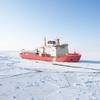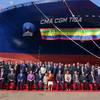Container Forecaster: Industry Conditions "Very Challenging"
According to Container Forecaster, the container industry is in dire need of a correction on the supply side and even the realization of a decent peak season demand surge this summer will not provide enough momentum to lift severely eroded freight rates in the key east-west trades.
Container operators will find it a very challenging environment this year in which to make money, but there is a major difference between this year and the recession ravaged 2009. We are forecasting an 8.1% growth in global container traffic for 2011 and so, other than rising fuel costs, responsibility for the inability to run their business models profitably can only be laid at the feet of the carriers themselves.
Ocean carriers have continued to launch new services in the key east-west trade lanes, many of them also upgraded with the latest 13,000 teu giants delivered from South Korean yards, but this has severely contributed to overcapacity with average load factors in the headhaul transpacific and Asia to Europe routes remaining at only 80-85%.
In this environment, freight rates have massively declined on the Asia to North Europe route where in some cases spot rates are not even covering quoted bunker surcharges of around $750 per teu. Planned rate restoration programmes have been postponed and there is little hope of carriers imposing meaningful peak season surcharges.
The industry knows that laying up ships is the answer and that attempts in withdrawal of limited capacity from the main east-west trades is not enough corrective surgery. The fact that many ships are just being recycled into other trade lanes is also merely transferring the pain elsewhere. Neil Dekker, editor of the Container Forecaster, said: “Contrary to what happened in 2009, there is currently no common strategy or discipline among carriers to lay up ships to redress the supply/demand balance.”
The fuelling of the newbuild market is not helping current sentiment and we are running the risk of repeating the mistakes of the ordering frenzy of 2007/08 – the legacy of which the industry is still paying for now. Two million teu of capacity has been ordered in the last 12 months and 80% of this is in the 8,000+ teu sector. Despite fears of a lack of funding from the financial sector, this does not appear to be a problem and some Greek owners are even placing speculative orders.
Dekker commented: “The dilemma is that each carrier is aware that its top priority is to be cost-competitive, even if the collective impact of individual orders for lower unit-cost vessels is weakening the market.”
The outcome is that we are forecasting a 20.8% year-on-year decline in 2011 for average east-west freight rates (excluding fuel) – during a period when container volumes have remained strong. Carriers have got it wrong this year and there has been an unwelcome and very quick return to the massive freight rate volatility so loathed by the shipper community.
With current mid-year fundamentals in mind we forecast that the carrier industry could make significant losses in 2011. Maersk has highlighted that there needs to be a revolutionary way of thinking within the industry, but focusing on schedule reliability and environmental factors is not enough – carriers need to properly address the fundamental aspects of supply and demand. The deployment of 13,000 teu ships, as is happening at the moment, into trades with load factors of 80-85% will not realise the savings and economies of scale that were envisioned when the orders were originally placed.
(Source: Drewry Maritime Research)












